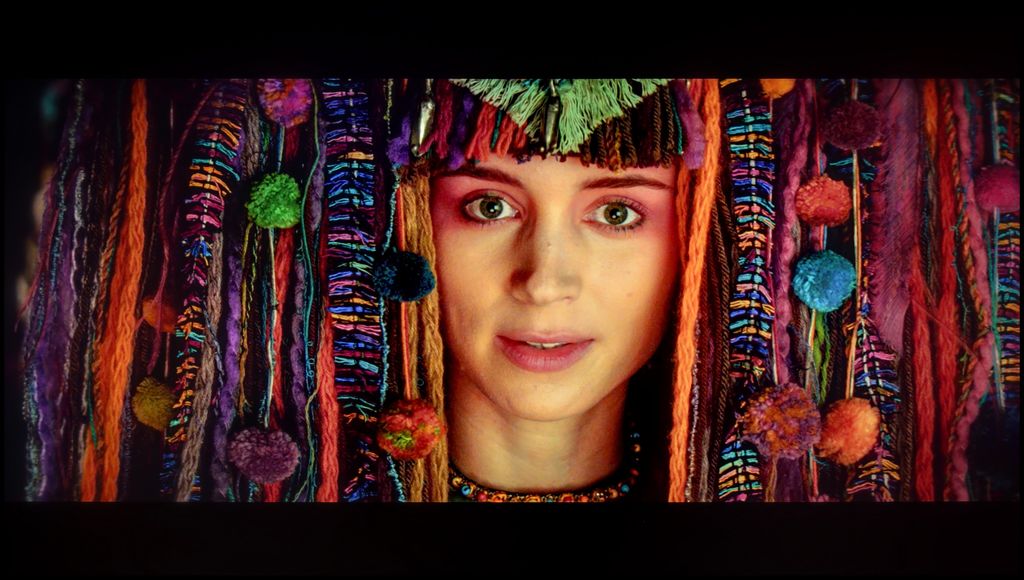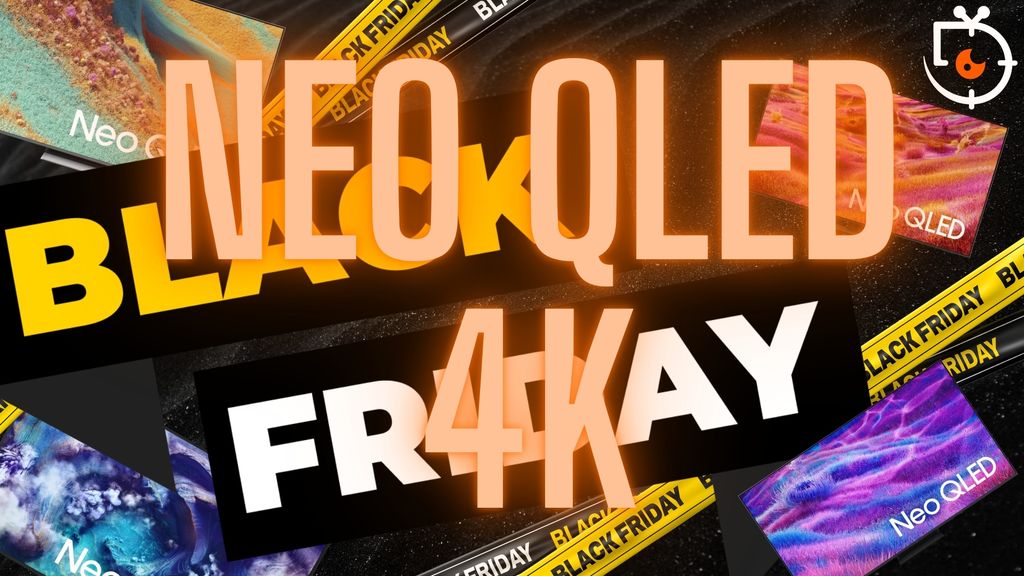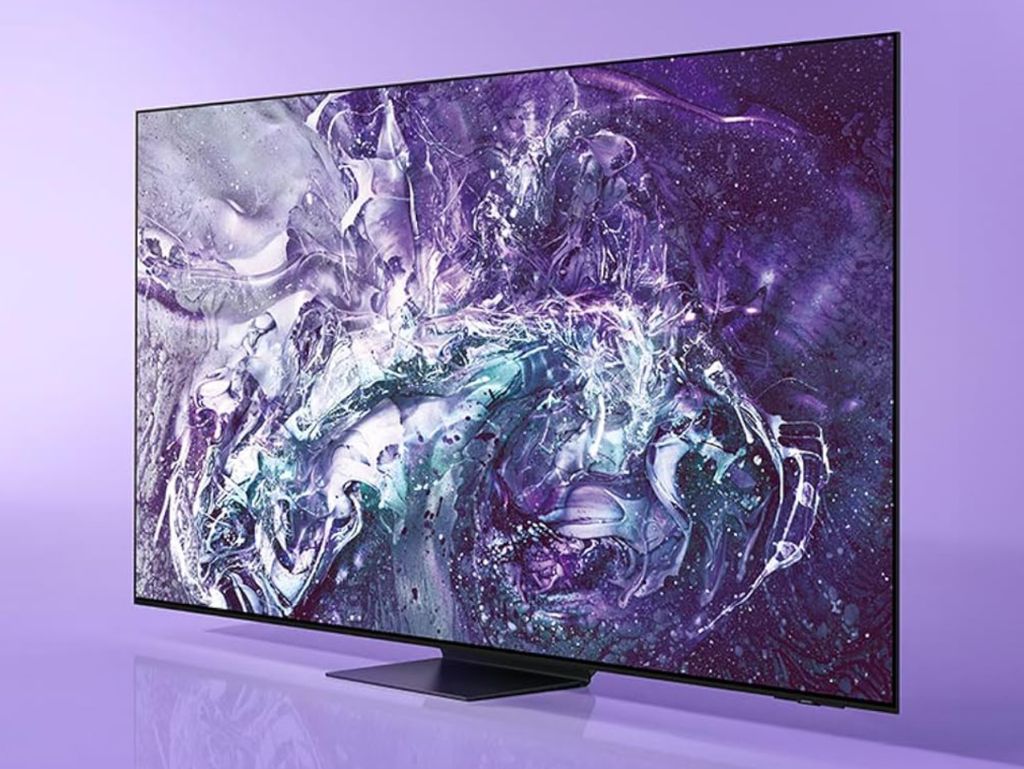- Matching (Score)
- Our verdict
- Competing TVs
- TV appearance
- Where to buy
- Contrast and black detail
- HDR effect quality
- Factory color reproduction
- Color reproduction after calibration
- Smoothness of tonal transitions
- Image scaling and smoothness of tonal transitions
- Blur and motion smoothness
- Console compatibility and gaming features
- Input lag
- Compatibility with PC
- Viewing angles
- Daytime performance
- TV features
- Apps
- Playing files from USB
- Sound
- Panel details
Samsung Neo QLED QN85D / QNX1D Review
Neo QLED / QN85D / QNX1D
Available screen sizes:

Complete the survey to find out the result
Panel type: LCD VA Refresh rate: 120Hz Brand: SAMSUNG Resolution: 3840x2160 System: Tizen Model year: 2024
SAMSUNG QN85D - Our verdict
7.4
Overall rating
The Samsung QN85D is the entry-level model in Samsung's 2024 Mini LED – Neo QLED lineup, offering a well-balanced mix of modern smart features and impressive picture quality. Running on the Tizen platform, the QN85D provides extensive support for Samsung's SmartThings ecosystem, enabling seamless integration with other smart devices in the home, regardless of brand. Apple users benefit from AirPlay compatibility, making content sharing from Apple devices straightforward, while the Daily+ feature adds an extra layer of engagement by delivering daily curated content, enhancing everyday use.
For regular viewing, the QN85D performs commendably. Its high brightness level allows it to easily handle well-lit rooms, and the central stand offers stability and aesthetic appeal. Though it lacks a recording function, the QN85D includes several practical features, such as a solar-powered remote that also controls Canal+ decoders, along with Picture-in-Picture (PiP) mode, enhancing versatility in various viewing situations.
When it comes to picture quality, the QN85D excels in contrast and brightness. Its VA panel delivers deep blacks when viewed directly, and the Mini LED technology provides improved backlight control (with some limitations), which is particularly effective in dark scenes. A refresh rate of 120 Hz ensures smooth handling of fast-paced scenes, while low input lag makes the QN85D an excellent choice for gamers and sports fans alike.
Overall, the Samsung QN85D stands out in 2024 as a robust, feature-rich TV with high picture quality and advanced smart capabilities, making it ideal for both everyday viewing and more demanding movie or gaming sessions.
Advantages
Nice Contrast with Mini LED Backlight
Ideal for gamers - 120hz, 4xHDMI 2.1, low input lag
Tizen operating system with SmartThings and AirPlay support – wide integration and flexibility
High brightness 825 cd/m² – Performs well in bright rooms
Pleasant sound with noticeable bass
Disadvantages
Lack of recording function
Limited support for multimedia formats, no DTS audio format
Movies and series in UHD quality
6.7
Classic TV, YouTube
6.8
Sports broadcasts (TV and apps)
6.7
Gaming on console
8.9
TV as a computer monitor
7.6
Watching in bright light
7.3
Utility functions
7.4
Apps
8.7
Sound quality
7.0
Complete the survey to find out what fits your preferences
SAMSUNG QN85D - Competing TVs in this price range
SAMSUNG QN85D - TV appearance
HDMI inputs: 0 x HDMI 2.0, 4 x HDMI 2.1 (48Gbps) Outputs: Toslink (Optical audio), eARC (HDMI), ARC (HDMI) Network Interfaces: Wi-Fi 2.4GHz, Wi-Fi 5GHz, Ethernet (LAN) 100Mbps
Build quality: Good
Stand type: Central
Bezel color: Graphite








Stand: Fixed
Flat design: Yes
Accessories: Stand
Buy at the best price
Select size:
SAMSUNG QN85D - Contrast and black detail
7.6/10
Local dimming function: Yes, number of zones: 120 (12 x 10)

Result
107,750:1

Result
27,100:1

Result
62,500:1

Result
8,750:1

Result
4,950:1
Visibility of details in the lights:

The 2024 Samsung QN85D stands out as the first model in the Neo QLED series to use a VA panel, allowing for significantly better blacks than the IPS/ADS alternatives. For the 55-inch version, the TV is equipped with 160 dimming zones. While this is fewer than some competing models, particularly those from Chinese brands, the number increases with larger screen sizes, enhancing contrast further.
However, the limited number of dimming zones can present challenges. When displaying smaller bright elements on a dark background, the TV may either keep the brightness high—resulting in a halo effect around objects—or dim the image too much, which is evident in specific test scenes like the Pioneer disc. In more contrast-intensive scenes, such as Oblivion, the TV showcases impressive depth in blacks, though it sometimes struggles with precise light separation, attempting to maintain black levels while sacrificing some detail in brighter areas. These trade-offs affect overall perceived contrast, particularly in demanding viewing conditions.
Despite these limitations, the QN85D’s performance in contrast remains strong for its category, especially compared to TVs without local dimming, where the results are generally more impressive than anticipated.
Halo effect and black detail visibility:
SAMSUNG QN85D - HDR effect quality
5.6/10
Supported formats: HDR10, HDR10+, HLG Color gamut coverage: DCI P3: 94.6%, Bt.2020: 77.5%
Luminance measurements in HDR:

Result
999 nit

Result
335 nit

Result
562 nit

Result
182 nit

Result
855 nit
The HDR performance of the Samsung QN85D is a mixed bag. While it excels in synthetic luminance tests, reaching up to 1000 nits, and delivers impressive results in scenes with full-screen brightness – like in The Meg or the opening of Life of Pi – the limitations become apparent when smaller bright elements are introduced. In these cases, the brightness level noticeably dips, weakening the HDR effect and reducing its impact. When brightness hovers around 200-300 nits, the immersive “wow factor” of HDR tends to diminish, and visuals lose some of their intended brilliance.
That said, the QN85D still manages to deliver decent colour quality, covering 95% of the DCI-P3 colour space, which, while respectable, doesn’t set it apart from its top competitors. Colours appear accurate and vibrant, but the HDR experience could be more compelling if the brightness was consistently well-balanced across various content types.
Scene from the movie “Pan” (about 2800 nits)

Scene from the movie “Billy Lynn” (about 1100 nits)

In challenging scenes, the Samsung QN85D demonstrates considerable strengths, though with some mixed results. The luminance chart suggests a significant power reserve, raising our expectations for these tests. In Pan, for example, the TV effectively distinguished sunlight from surrounding elements, though the overall scene appeared slightly less contrasty than the reference image.
On a brighter note, sequences from Billy Lynn were particularly impressive. The main character was portrayed with fine detail, capturing small imperfections on the skin, and the fireworks in the background retained their individual colours and clarity, avoiding a blurred or washed-out appearance. This level of clarity highlights the TV’s adaptive capabilities in handling complex scenes.
Interestingly, we found that turning off the dynamic tone mapping produced a more natural image, as the feature can overly amplify brightness and contrast, detracting from the image's realism.
HDR luminance chart:
HDR luminance
The Samsung QN85D reveals noticeable differences when switching between static HDR and dynamic HDR10+ formats, showcasing the impact of dynamic metadata on image quality. For instance, in a typical opening scene, static HDR often flattens the visuals, merging elements into a uniformed, bright area where fine details are lost and depth is lacking. This approach can leave elements like textures and background nuances looking average and unengaging.
However, when viewing the same scene with HDR10+, the image transforms. Blades of grass, light reflections, and background elements like distant forests become distinct, adding depth and a natural quality to the visuals. Thanks to dynamic metadata, lighting effects appear more lifelike, and detail retention improves significantly, even in high-contrast scenarios.
The absence of Dolby Vision support is a drawback, as it remains one of the most widely used HDR formats. Without it, the QN85D misses out on potential improvements in scenes where static HDR might fall short, making dynamic HDR a key advantage for this model.
Static HDR10

Dynamic: HDR10+

Factory color reproduction
6.3/10
The Samsung QN85D, when tested in Filmmaker Mode, falls short of expectations for film accuracy due to several notable issues in colour and brightness reproduction. In HD content, the white balance is skewed by an excess of red and blue, causing a pinkish tint across the image. This effect, confirmed by Colour Checker tests, impacts the realism of skin tones and other details, becoming particularly distracting in complex scenes.
For 4K HDR content, while the white balance intially appears accurate, there is a pronounced shift towards blue tones at the upper end of the spectrum. This deviation results in colours that lack natural appeal, subtly detracting from the viewing experience. The gamma, although close to the standard reference, slightly dips below the ideal 2.4 level, reducing shadow depth. Moreover, the EOTF curve for 4K content is noticeably elevated above the reference line, leading to excessive brightness in certain image areas. This undermines the cinematic look Filmmaker Mode aims to deliver, creating a visual experience that feels over-bright rather than authentically nuanced.
In summary, while Filmmaker Mode on the QN85D initially presents a cinematic effect, the inaccuracies in colour balance and brightness are too significant to achieve the true-to-source quality that the mode promises.
Color reproduction after calibration
7.9/10
After professional calibration of the Samsung QN85D’s Filmmaker Mode, there's a noticeable enhancement in HD/SDR content quality. The calibration eliminates major issues with white balance, and adjustments to the brightness characteristics result in a more natural and lifelike picture. Regular HD content, like television broadcasts and YouTube videos, now benefits from well-balanced colours, free from the distracting hues that previously impacted image quality.
However, challenges remain with 4K HDR content. Despite calibration, improvements in white balance for HDR are minor, and more cosmetic than transformative. The EOTF curve initially aligns with reference standards in test conditions, but the television struggles to maintain consistent brightness during film scenes. As a result, dark elements appear overly boosted in mixed scenes, creating excessive contrast. In fully dark scenes, the image often becomes too dim, obscuring finer details and diminishing the overall viewing experience. This inconsistency in brightness affects the depth and accuracy of HDR performance, especially in more challenging scenes.


SAMSUNG QN85D - Smoothness of tonal transitions
7.6/10
When it comes to the smoothness of tonal transitions on the Samsung QN85D, it is generally very good. The tonal transitions are smooth, with no significant artefacts. However, more discerning users may notice some minor issues in certain scenes. For example, when blending darker colours, such as in the scene with the red sea, subtle imperfections can be observed. Similarly, with bright colours – the scene from the movie The Martian displays slight gradation issues, resulting in subtle but noticeable transitions between shades. Despite these minor drawbacks, most users will likely be satisfied. The overall performance remains high and in most cases, it delivers smooth, natural transitions between colours.








Image scaling and smoothness of tonal transitions
7/10
Smooth transition function

Image without overscan on the SD signal

When assessing the fluidity of tonal transitions in low-resolution materials on the Samsung QN85D, it's important to consider the noise reduction feature, which significantly improves problematic tonal transitions. However, this feature also has its drawbacks – it removes film grain, a crucial element in many productions that adds authenticity, and it can also soften the image. While this may appeal to those who prefer a smoother image, film enthusiasts who favour the authentic look of films may want to use this feature sparingly.
In terms of image scaling, the television performs very well. The model's figure is presented correctly, without noticeable distortions, and the branches in the background do not suffer from excessive artificial sharpness, a common issue when scaling lower-resolution content. The high capabilities of the image processor are evident, as it effectively handles lower-quality materials, ensuring a high-quality final image.
SAMSUNG QN85D - Blur and motion smoothness
7.5/10
Maximum refresh rate of the panel: 120Hz
Film motion smoothing option: Yes
Blur reduction option: Yes
BFI function 60Hz: Yes, 60Hz (image flickers)
BFI function 120Hz: No
Brightness drop with BFI: 75%

The Samsung QN85D’s display boasts a 120 Hz refresh rate, which should satisfy both gamers and sports enthusiasts, providing a smooth and dynamic viewing experience. There are options for further improving fluidity, including a blur and judder reduction feature that allows precise adjustment of motion smoothness on a 10-point scale. Blur reduction enhances the sharpness of fast-moving objects, making action scenes clearer, while judder reduction smooths motion to eliminate the "stuttering" effect. Ghosting is generally well-controlled, although minor drawbacks may be noticeable in more demanding scenes, particularly when an object moves against a dark background. Additionally, the television features a BFI (Black Frame Insertion) option at a 60 Hz frequency, which can significantly enhance motion smoothness, although it comes with the potential downside of flicker, which may be bothersome for some viewers.
Blur (native resolution, maximum refresh rate):



SAMSUNG QN85D - Console compatibility and gaming features
9.5/10
ALLM: Yes
VRR: Yes
VRR range: 48 - 120Hz
Dolby Vision Game Mode: No
Correct implementation of HGIG: Yes
1080p@120Hz: Yes
1440p@120Hz: Yes
4K@120Hz: Yes
Game bar: Yes


The Samsung QN85D is an excellent choice for gamers, offering a wide range of features that elevate gameplay quality and make it even more immersive. With a 120 Hz refresh rate, the image remains incredibly smooth, crucial during fast-paced action scenes in games. The TV also boasts low input lag, making player responses to commands almost instantaneous, enhancing control over characters and events on screen. Additionally, the Samsung QN85D supports VRR (variable refresh rate) and ALLM (auto low latency mode) technologies, optimising image fluidity and reducing lag by automatically adjusting the TV to meet gamers' needs.
The Xbox app, which enables cloud gaming without requiring a console, is another significant advantage, offering a seamless gaming experience without the need for additional hardware – a feature that sets Samsung TVs apart. The Auto Motion Plus Game feature is another notable addition. This motion smoother simulates a higher frame rate, making 30 fps games appear smoother, akin to 45 fps, while games at 60 Hz are upgraded to a 90 Hz experience. Most importantly, this feature does not introduce significant lag, ensuring the comfort of gameplay remains intact. It allows gamers to enjoy a smoother image without compromising responsiveness.



SAMSUNG QN85D - Input lag
9.9/10
The Samsung QN85D impresses in terms of input lag value. The TV achieves remarkable results – below 15 ms for 60 Hz content and around 10 ms for 120 Hz content. This allows gamers to enjoy instantaneous reactions to their actions, especially in dynamic games where every millisecond counts. Such low input lag makes gameplay more responsive and natural, enhancing the overall gaming experience.
| SDR | HDR | Dolby Vision |
|---|---|---|
| 1080p60: 14 ms | 2160p60: 14 ms | |
| 1080p120: 10 ms | 2160p120: 10 ms | |
| 2160p60: 14 ms | ||
| 2160p120: 10 ms |

SAMSUNG QN85D - Compatibility with PC
7.6/10
Chroma 444 (maximum resolution and refresh rate): Yes
Font clarity: Very Good
Readability of dark text and shapes: Average
Input lag in PC mode (4K, maximum refresh rate): 10ms
Matrix subpixel arrangement: BGR
Max refresh rate: 120Hz
G-Sync: Yes
The Samsung QN85D can be a solid option as a computer monitor. Its support for 4:4:4 chroma (available only in "Game" mode) ensures that text on the screen remains sharp and easy to read, which is essential for tasks such as working with text documents or spreadsheets. A notable advantage of this model is its exceptionally low input lag in "PC" mode – just 9 ms, providing excellent smoothness and responsiveness, making it suitable for both productivity tasks and gaming.
However, there are a few drawbacks. When displaying fonts on a dark background, an issue becomes apparent – zooming in on an image reveals that horizontal lines appear darker than vertical ones. This is because the subpixels in these areas do not fully illuminate, which seems to be a flaw in the algorithm responsible for rendering thin lines. As a result, text quality on dark backgrounds is not optimal. Despite this, the TV remains a solid choice as a PC monitor, especially given its low input lag and support for 4:4:4 chroma.
SAMSUNG QN85D - Viewing angles
2.9/10
Brightness drop at an angle of 45 degrees: 84%
The Samsung QN85D, due to its VA panel, has relatively poor viewing angles. When viewed from the side, colours lose their intensity, with less image contrast. This is a common drawback of VA panels, which generally offer significantly worse image quality when viewed from wider angles. However, when viewed directly in front of the TV, the situation improves considerably – the VA panel provides deep blacks and better contrast, which is a notable advantage if the TV is mainly watched from a central position.
SAMSUNG QN85D - Daytime performance
7.3/10


Panel finish: Satin
Reflection suppression: Average
Black levels during daytime: Good
The Samsung QN85D performs excellently in bright daytime conditions. Although the satin panel moderately suppresses reflections, its impressive brightness level of 825 cd/m² ensures that the TV remains highly readable even in bright sunlight. Large external light sources do not pose a significant issue, making this model a great choice for rooms with plenty of natural light.
Panel brightness
Average luminance SDR
Samsung Neo QLED QN85D / QNX1D: 825 cd/m2
SAMSUNG QN85D - TV features
7.4/10
System: Tizen
System performance: Very good
- HDMI inputs: 0 x HDMI 2.0, 4 x HDMI 2.1 48Gbps
- Outputs: Toslink (Optical audio), eARC (HDMI), ARC (HDMI)
- Network Interfaces: Wi-Fi 2.4GHz, Wi-Fi 5GHz, Ethernet (LAN) 100Mbps
- TV reception: DVB-T, DVB-T2, DVB-S, DVB-S2, DVB-C
Classic features:
Recording to USB (terrestrial TV): No
Recording programming: No
Picture in Picture (PiP): Yes
RF remote control (no need to aim at the screen): RF
Backlit remote control: No
Teletext: Yes
Audio only mode: Yes
Bluetooth headphones support: Yes
Simultaneous Bluetooth headphones & TV audio: Yes
Smart features:
AirPlay: Yes
Screen mirroring (Windows Miracast): Yes
Voice search: Yes
Voice search in native language: Yes
Ability to connect a keyboard and mouse: Yes




The Samsung QN85D offers a comprehensive range of smart features thanks to the Tizen platform. Users can access a variety of apps and functions, including SmartThings, which allows them to control not only Samsung devices but also products from other brands, enabling the creation of a fully integrated smart home ecosystem. The TV also supports AirPlay, making it easy to stream content from Apple devices directly to the screen, adding to its versatility and convenience.
This model stands out with its unique features as well. It includes Daily+, which provides diverse content daily, such as fitness exercises or workspace ideas. In terms of design, while it may not be as slim as last year's models, the TV still boasts a sleek and attractive look. The central stand offers solid support and enhances the overall elegance of the device.
In terms of user functions, the TV comes with a remote control compatible with decoders like Canal+, allowing users to control most home equipment with a single device. Additionally, the PiP (Picture-in-Picture) function lets viewers watch two image sources simultaneously. However, a notable drawback is the lack of a recording function, which may be a significant downside for some users.
Sound connection options
HDMI audio:
Other audio outputs:
Toslink: Yes
Wireless audio:
Bluetooth: Yes
Supported audio formats (external HDMI eARC audio):
Dolby Digital Plus 7.1: Yes
Dolby True HD 7.1: No
Dolby Atmos in Dolby Digital Plus (JOC): Yes
Dolby Atmos in Dolby True HD: No
DTS:X in DTS-HD MA: No
DTS-HD Master Audio: No
Senior accessibility
Numeric keyboard on TV: No
Font size adjustment: Yes
Audio description: Yes
SAMSUNG QN85D - Apps
8.7/10























SAMSUNG QN85D - Playing files from USB
9.1/10

| Maximum photo resolution: | Supported photo formats: |
|---|---|
The built-in player on the Samsung QN85D should meet the needs of most users. It supports popular video and audio formats without major issues, providing solid compatibility with widely used codecs. However, more discerning users may notice some limitations – for instance, it does not support playing photos in the HEIC format, which is commonly used by Apple devices, nor does it handle several other less common photo formats.
SAMSUNG QN85D - Sound
7/10
-
Maximum volume
Supported codecs
(TV speakers)
Dolby Digital Plus 7.1
Dolby True HD 7.1
Dolby Atmos in Dolby Digital Plus (JOC)
Dolby Atmos in Dolby True HD
DTS:X in DTS-HD MA
DTS-HD Master Audio
The sound on the Samsung QN85D television is pleasant, with a subtle bass feel and clarity across the entire volume range. This is thanks to the built-in 2.2 40W speakers. Unfortunately, the lack of DTS audio format support may be problematic for users looking to enjoy a full audio experience. In such cases, it will be necessary to use an external player to get support for this format.
Acoustic Measurements
No acoustic data
SAMSUNG QN85D - Panel details
Software version during testing: 1120
Subpixel Structure:

Panel uniformity and thermal imaging:
Backlight Type: Mini-LED QLED

Founder and originator of the "ChooseTV" portal

Journalist, reviewer, and columnist for the "ChooseTV" portal
See articles related to Samsung Neo QLED QN85D / QNX1D:
12/1/2025
Our YouTube channel
Settings for Samsung QLED and OLED TV [Movies, Sports, TV, G... 10/16/2025
3/6/2025
1/16/2025











